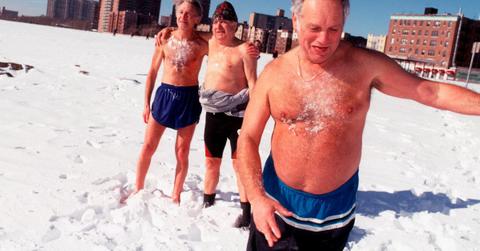Unexpected Twist: Polar Vortex Spinning in Unusual Direction Causes Extreme 'Ozone Spike,’ Arctic Warming

The polar vortex has rapidly reversed its direction.
The polar vortex, known for bringing freezing temperatures to densely populated areas during winter, has recently displayed an unexpected phenomenon.
Instead of its usual rotation, the vortex abruptly reversed its spin, leading to an "ozone spike" detected above the North Pole, according to experts.
According to reports from Spaceweather.com, this reversal occurred abruptly last month marking the sixth fastest event of its kind since 1979. The resulting ozone spike was unprecedented, representing the strongest occurrence since records began.
This event, the second reversal of the polar vortex in 2024, follows a smaller incident in January that caused a localized cold snap in parts of America.
Despite concerns, experts suggest that this reversal is unlikely to plunge lower latitudes into a deep freeze, partly due to its deceleration. Nonetheless, it was catalyzed by a "sudden stratospheric warming event" above the North Pole, leading to the ozone spike.
The polar vortex reverses direction when natural waves, influenced by Earth's rotation, penetrate the polar stratosphere — a region above the safe altitude for commercial flights but below where most meteors disintegrate.
This intrusion accelerates the transport of ozone from the tropics to the Arctic, causing stratospheric temperatures to rise by up to 90 degrees Fahrenheit.
While the polar vortex appears to be slowing down, experts anticipate its return to its customary counterclockwise rotation soon.
- Doomsday? Scientists Warn This Possible Change on Earth May Have Major Impact on Climate and Technology
- Sudden and Rare Change in Mars' Atmosphere Raises Possibility of Similar Occurrence on Earth, Scientists Say
- What Lies Beneath: NASA Scientist Believes Aliens May Have Found 'Perfect' Hiding Spot in Earth's Oceans
Despite ongoing declines in sea ice levels, the vortex's recent behavior hasn't triggered any significant Arctic weather anomalies beyond the overarching trend of global warming.
Typically, a robust polar vortex features stratospheric winds similar to those of a Category 5 hurricane, trapping frigid Arctic air and maintaining moderate temperatures in more southerly regions.
However, when the vortex weakens, it allows Arctic air to spill southward via the polar jet stream, resulting in deep freezes and unseasonably cold weather.
Never miss a story — sign up for the Front Page Detectives newsletter. Be on the scene the moment news breaks.
The concept of polar vortexes has gained prominence in mainstream American discourse, as recurrent severe cold spells have become part of the winter experience. Researchers hold varying views on whether weakened polar vortexes will become more frequent as global warming persists.
While some argue that warming trends induce a "torquing" effect leading to vortex disruptions, others suggest that the correlation between unusual weather events and polar vortex behavior diminishes over extended periods, hinting at natural variability.
Furthermore, polar vortex activity is intertwined with El Niño and La Niña weather patterns, with vortexes more prevalent during El Niño phases when ocean temperatures rise naturally. Currently, the planet is nearing the conclusion of a significant El Niño period that commenced in June 2023, anticipated to end in May or June 2024, paving the way for a transition to a La Niña phase later in fall 2024.
Become a Front Page Detective
Sign up to receive breaking
Front Page Detectives
news and exclusive investigations.
